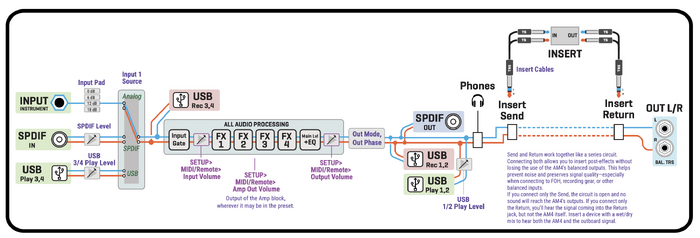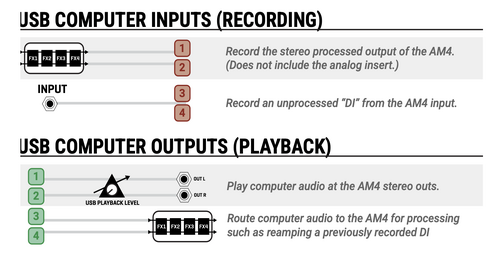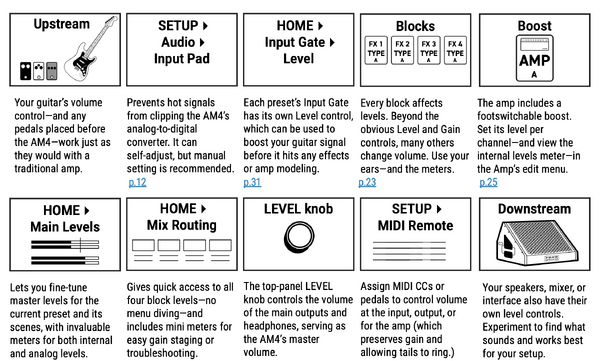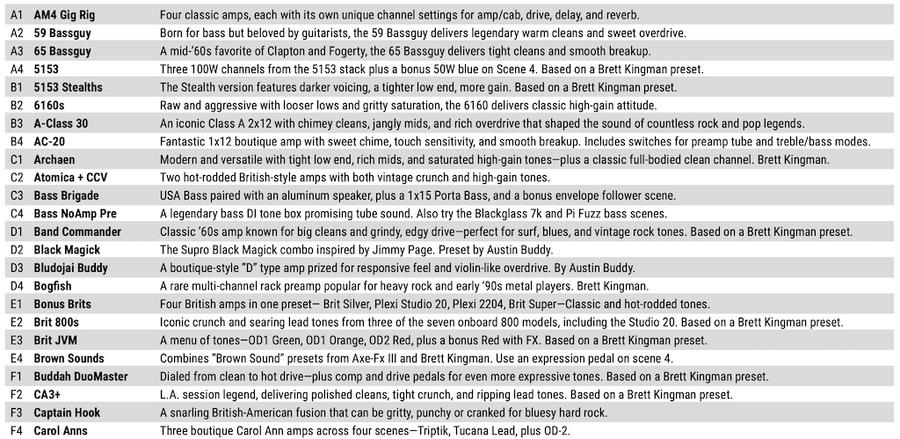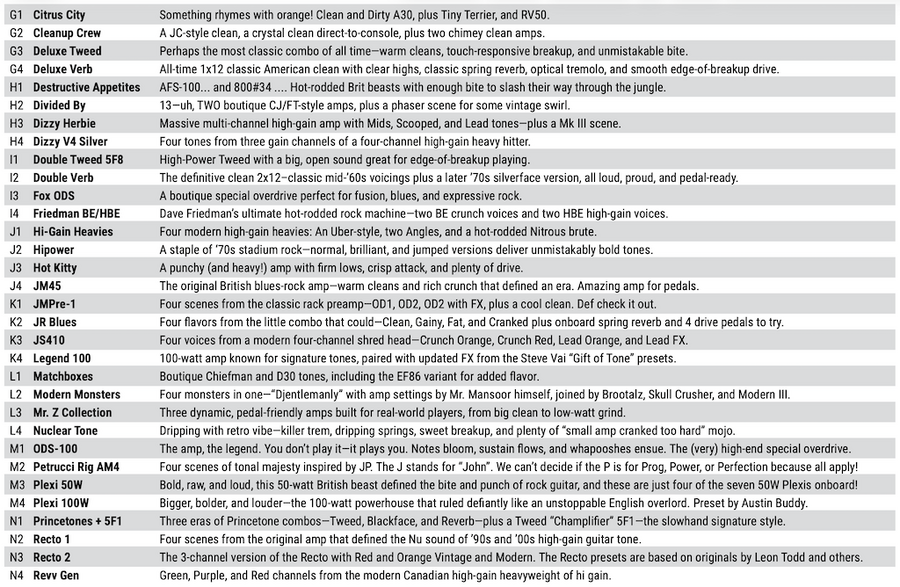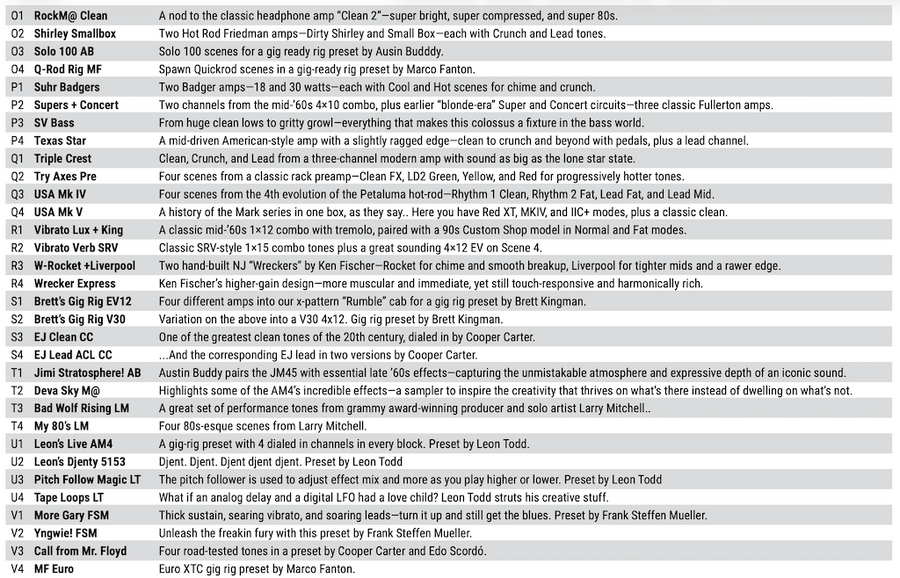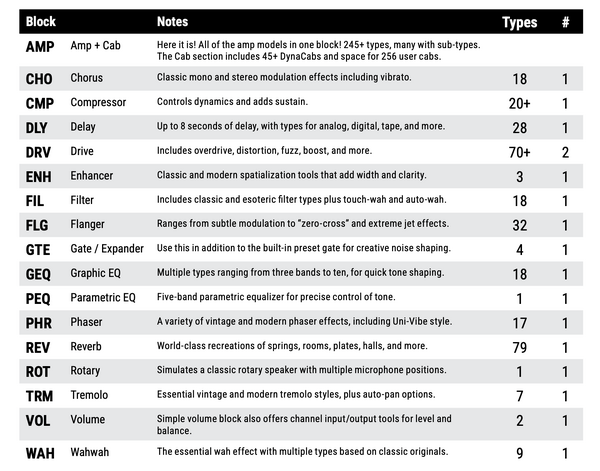This is the wiki for products made by Fractal Audio Systems, maintained by members of the community.
The wiki is being updated from A to Z with information about the new AMP4 amp modeler
AM4 amp modeler
Information is being added to this page as it becomes available
Contents
References
Read the excellent owners manual first!
Documentation:
Pictures
See “Owners show their AM4 boards” for a discussion how forum members are using their AM4 units.
Comparing AM4, VP4 and FM3
Fractal Audio: [1]
AM4 vs VP4:
AM4 and VP4 both deliver Fractal Audio’s industry-leading sound quality, world-class effects, and rock-solid reliability. They're the same size and form factor and use streamlined UI designs that are intended to be as easy to use as real pedals. The two products share the same core technologies used across the Fractal Audio product family. They both also offer "gig mode" footswitch operation, gapless switching, USB audio, MIDI, professional connectivity including Auto-Z analog in and SPDIF I/O, plus optional "expert" editing—on the device or with companion software. The difference is largely down to features around intended use:
The AM4 delivers top-tier amp tone and effects. We say it is "perfect for a pedalboard" but it is also an ideal standalone for a desktop or "fly rig". It includes the full AM4 Amp block with integrated DynaCab™ speaker simulation, UltraRes™ user cabs, plus a selection of stompbox and studio effects. It has balanced line level outputs, a top panel level knob, a headphones output, and a stereo analog insert for using 3rd part "post" FX without the need for a separate DI box.
The VP4 delivers Fractal Audio effects for use with any amp or modeler. It does NOT perform amp modeling but it does have multiple instances of almost every effect block from the Axe-Fx III including the new IR Player. It has unbalanced outs and is unity-gain by design so no top panel level knob or headphones jack. It has a mono 4CM mode for running pre and post effects at the same time. The VP4 works extremely well as a sidekick to AM4 (AM4+VP4 = "MVP-8").
AM4 vs FM3:
FM3 and AM4 both deliver Fractal Audio’s industry-leading amp modeling, world-class effects, and pro-grade sound quality. They’re both based on the Axe-Fx III, with rock-solid reliability on stage or in the studio. Both include gapless switching, precision tuning, USB audio, MIDI, flexible I/O, and deep editing options—whether on the device or with companion software. No matter which you choose, you’re getting Fractal Audio quality tone and performance.
The main differences are simplicity, size, and price. The AM4 is designed to be lean and mean: easy to use, small, and our best priced modeler ever. The FM3 is more of a “little brother” in the Axe-Fx family in terms of flexibility and features. It's bigger than the AM4.
The AM4 delivers top-tier amp tone and effects in a small, light, streamlined package. It has fixed four-block architecture, a shorter list of block types, simplified routing and footswitch options, and an interface designed to feel very much like amps and stompboxes. It’s ideal for pedalboards or anyone who wants great tone with minimal setup. The AM4 also includes S/PDIF in and out, a dedicated USB-MIDI port that appears in a DAW, and an analog insert for post effects—allowing you to use the onboard balanced outputs without needing a DI box. It has 104 preset slots with four scenes each.
The FM3 is slightly larger and heavier but also more full-featured. It offers a flexible grid-based preset system with more block types including a looper, plus deeper routing options, and highly customizable footswitches including FC controller support—essentially a downsized “mini Axe-Fx” on the floor. It includes S/PDIF out and an extra pair of stereo ins and outs that can be used creatively for send/return, split routing, or auxiliary processing. It's your big rig in a small box, with 512 presets and eight scenes per preset. The FM3 can share presets with Axe-Fx, FM9, and FM3 within its own limits.
Using the AM4 and VP4 together
There are various ways to combine the AM4 and VP4.
- VP4 Out > AM4 In (analog)
- Connect the output jack on the VP4 to the instrument input on the AM4.
- AM4 Out > VP4 In (analog)
- Connect the output jack(s) on the AM4 to the analog input(s) on the VP4.
- VP4 > AM4 (SPDIF)
- Connect SPDIF Out on the VP4 to SPDIF In on the AM4.
- AM4 > VP4 (SPDIF)
- Connect SPDIF Out on the AM4 to SPDIF In on the VP4.
- AM4 >< insert VP4 (analog)
- Put the VP4 in the insert loop of the AM4, using an insert cable.
- VP4 >< 4CM AM4 (analog)
- Set to the VP4 to 4CM, and put the AM4 in loop of the VP4.
Use MIDI Program Changes or "Scene Sync" to synchronize switching on both devices.
Specifications
Design and development
The AM4 has the same audiophile specs as the Axe-Fx III. [2]
Processing and memory
A meter in the upper right shows the current CPU usage. To ensure smooth performance, a limit of about 85% is enforced, leaving required processing power in reserve. If this limit is exceeded, a warning will be shown: “CPU LIMIT: Bypassed" and the AM4 will bypass all processing.
The CPU metering is dynamic: the amp modeling running on the core is actively metered during play. The manual recommends aiming for max 80% when not playing and then playing the preset to ensure stable performance.
FRACTAL AUDIO QUOTES
[3] The processor in the AM4 is faster than the VP4.
[4] AM4 uses the same family of CPU as in the Axe-Fx III. It is a 1 GHz processor with an ARM A15 CPU and a C66x DSP. Therefore it has half the power of a standard Axe-Fx III.
Latency
Information will be added when it becomes available.
See Latency for more information.
Screen
The display is a 480 x 272 high-contrast color LCD.
The AM4 does not have a touchscreen.
Dimensions and weight
- Weight
- 3 lbs 9 oz (1.63 kg)
- Dimensions
- 10.00" x 6.31" (254mm x 160.3mm)
Power
The power connector is a 2.1mm barrel connector, with a negative center. The power-supply (9V DC, 1.5A) is included.
Do NOT use an AC supply. It WILL damage the unit.
The AM4 has a power button. The unit boots in a few seconds and DynaCabs will begin to pre-load automatically in the background. You may experience brief slowdowns while the cabs are loading. This is normal and ends once all cabs have finished loading.
FRACTAL AUDIO QUOTES
[5] The AM4 is spec'd at 1.5A. It uses slightly more power than a VP4 due to the higher clock speed. Most units will consume less than 1.3A but due to unit-to-unit variation we cannot guarantee that.
[6] Like our other products, the AM4 has a high-voltage analog path. The analog path runs off 24V (linearly regulated from 30V). This is done to ensure ample headroom, low noise and plenty of output signal. It costs a bit more and uses a bit more power but our mantra is always quality first.
Analog I/O
Input
Mono instrument input, single 1/4" TS jack, max +20dBu (instrument level).
Input impedance is variable and is adjustable per preset.
The Input pad in SETUP is adjustable, with auto correction. The manual states that the AM4 is pre-configured for a typical guitar with hot pickups. If input clipping occurs, an ”IN CLIP“ warning is displayed and the Input Pad setting is temporarily increased.
OWNERS MANUAL
If the input of the AM4 clips persistently, the unit will automatically increase the Input Pad setting. When this occurs, the word “Auto” will appear next to the Input Pad value, for example: “12 dB (Auto)”, indicating that the pad was automatically increased to 12 dB. When you reboot the AM4, the automatic setting is cleared, and the last manually selected value is restored. If you want to make the automatic pad setting permanent, just turn the Input Pad knob one “click” to clear “Auto”.
Like the VP4, the input range of the AM4 is the same as an 18V pedal. [7]
Output
1/4" TS, L/R (mono/stereo), max +16dBu, 1 KOhm. Balanced. Line level. No Humbuster.
The output can be switched between mono and stereo in SETUP. See Mono vs stereo
The AM4 has a SPLIT output option, which sends the signal with cab modeling to Left (for FOH), and a "no cabinet" signal to Right. Each output operates in summed mono.
FRACTAL AUDIO QUOTES
[8] The 1/4" jacks are balanced TRS. If you need XLR you can use an adapter.
4CM
4CM (Four Cable Method) is NOT supported.
Analog insert
The AM4 does not provide an effects loop. But it has a fixed insert point between the internal effects and the balanced outputs. Use these to connect outboard gear while preserving the clean, low-noise performance of the balanced outputs for FOH without needing a direct box. The insert is fixed in hardware and cannot be repositioned or switched on/off. It applies only to the main outs and is not heard on USB or SPDIF.
For mono, use a standard patch cable. For stereo, use a TRS-to-dual-mono insert cable (tip = left, ring = right).
- Insert Send: 1/4" jack TRS (tip=Left, ring=Right), 1 KOhm, 16dBu
- Insert Return: 1/4" jack TRS (tip=Left, ring=Right), 1 MOhm
FRACTAL AUDIO QUOTES
[9] The idea is you put your pre effects before the unit and your post effects (should you need any) in the insert. The outputs of the AM4 are balanced and designed to be sent directly to FOH and/or monitors. If you just put your post effects after the unit you would then need a DI to go to FOH.
[10] A freely positionable loop would require another stereo A/D and D/A would would increase power consumption, latency when the loop is active, noise, etc. Its purpose is simply to get your post effects before the DI. A typical pedal board might be something like: Wah -> Fabled Unicorn Devices (FUD) Dry Hump III Overdrive -> AM4 -> Lunar Electronics Space Echo Plus. The Space Echo Plus is your typical pedal with unbalanced I/O. You put in the insert loop on the AM-4 and the outputs of the AM-4 are balanced for FOH/Monitors.
Analog bypass
The AM4 currently does not provide an analog bypass mode, like the VP4 has.
FRACTAL AUDIO QUOTES
[11] The AM4 has an analog bypass but it's currently not implemented. I can't guarantee that it's something we will implement but the capability is there.
Headphones
The AM4 has a 3.5mm stereo headphones port.
Impedance is 35Ω. Recommended headphone impedance is less than 600Ω.
Digital I/O
Converters
24-bit, 48kHz (fixed).
Dynamic range is 114 dB, 20-20k frequency response.
USB
USB-C port for data and audio.
MIDI-over-USB is supported.
USB Audio 2.0 provides 4 channels (2x2) at 48kHz.
- OUT channels 1+2: processed output
- OUT channels 3+4 : unprocessed (copy of inputs)
- IN channels 1+2: send incoming USB Audio directly to outputs
- IN channels 3+4 : process incoming USB Audio and send to outputs
Windows computers require a software driver which is available on the AM4 Downloads page.
See USB for more information.
Note that an USB connection can create a a ground loop, resulting in noise or hum. To prevent this:
- Switch a laptop between AC power and battery power.
- Use balanced cables.
- Insert a USB ground loop eliminator (Type-C > Type-C) between AM4 and computer.
- Try an audio isolation transformer between AM4 and device.
SPDIF
SPDIF can be used to digitally connect the AM4 to an VP4, FM3, FM9 or Axe-Fx, through RCA connectors, at 48kHz fixed sample rate.
A digital connection avoids the necessary A/D and D/A conversion and inherent latency that comes with analog-to-digital connections.
IMPORTANT: When using the VP4 and AM4 together through SPDIF, in whatever order, make sure to crank the SPDIF In Level on the receiving device, to prevent loss of signal level and possibly gain. Also select SPDIF as input source on the 2nd device. And if the AM4 goes first, crank its hardware LEVEL knob.
Read Digital I/O and recording for more information.
Firmware
The firmware is upgradeable, allowing adding new features and bug fixes.
You can download the latest official release from the AM4 downloads page.
Public beta releases are often released on the user forum.
Control
User interface
Compared to Fractal's modelers, the AM4 UI is simplified and streamlined, like the VP4.
Press + together to enter the “Mode Select” menu which allows you to select between Preset, Scene, Effects, Amp and Tuner/Tempo. The mode determines what's displayed on the LCD, how the Select knob operates and what the switches do.
The factory default's “Gig Mode” configuration makes it easy to select presets, scenes, effects, channels, tuner and tap tempo. The startup mode can be set in Setup.
Press + together to enter Setup.
To edit parameters on the hardware, turn in Effect mode to highlight a block, press to edit the block, turn the corresponding knob to adjust the value, or to get to other pages.
When editing parameters on the hardware, press + together to enter “Expert Edit” mode. Expert Edit includes advanced parameters. Press to quit Expert Edit.
On the home page in FX Mode, select the desired block, hold the button, and turn to move.
Similar to the VP4:
FRACTAL AUDIO QUOTES
[12] Behind the scenes it's the architecture from the Axe-Fx III. There's still a grid and scenes and channels, etc. It's just that it's mostly hidden from the user and simplified.
Tip: If you don't need scene names, use the available space to indicate the specific effect types instead. Insert spaces to visually align them.
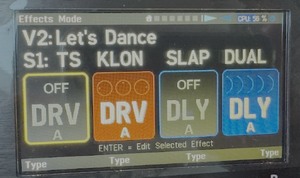
Levels
The AM4 has two stages that affect the overall volume.
- Internal levels operate within presets. These include Input Level, Scene Levels and Preset Level.
- Analog output level is controlled by the top-panel knob. Set it to the preferred but avoid overdriving the output stage or connected device(s). The Analog Levels meter shows how close you are to clipping, and an OUT CLIP warning will appear in the title bar across all pages if clipping occurs.
The AM4 outputs operate at adjustable line level, not at fixed unity gain.
AM4-Edit software editor
AM4-Edit is the editor for the AM4, with Fractal-Bot built-in.
You can download AM4-Edit, along with the Windows driver, firmware and factory presets updates, from the AM4 downloads page.

Onboard switches
The four foot switches have colored indicators, but no scribble strips.
They support Tap and Hold functions (e.g., to switch channels). Factory default is the so-called Gig Mode
. You can customize the functions.
MIDI
The unit has 3.5 mm (1/8”) MIDI IN and OUT ports. Adapters are available from Fractal Audio.
The Boss BMIDI-5-35 cable has been tested and works with the AM4 to connect to 5-pin MIDI gear.
The AM4 supports:
- Sending and receiving Program Changes (PC)
- Sending and receiving Control Changes (CC)
- MIDI-over-USB
- MIDI clock (receive only, currently)
- Software MIDI Thru
- Syncing scenes with the VP4
A table in the manual translates MIDI Program Changes to AM4 presets.
The AM4 tempo does respond to MIDI Beat Clock. It does not send MIDI Clock.
See MIDI for more information.
Expression pedals and external switches
The unit supports two expression pedal connections (TRS, 10–100 kΩ max), or two single TS external switches (momentary or latching).
The unit does not provide FASLINK connections and can't connect to FC-6 and FC-12 foot controllers foot controllers.
Amp switching
The AM4 itself does not provide relays to switch amp channels, but it can connect through MIDI to a relay switcher to perform that duty.
Possible solutions include:
- MIDI Solutions Relay
- Suhr MicroMIDI Control
- Voodoo Lab Control Switcher
- Pirate MIDI CLiCK
- RJM Mini Amp Gizmo (no longer available from RJM but might be available used. The manual is currently available online.)
- EM
Sound
Presets, scenes and channels
The unit has 104 presets, supports four scenes per preset and four channels per effect block.
The presets are organized into 26 banks, each identified by a letter from A to Z. Within each bank, there are four presets, numbered 1 through 4.
Each block has 4 channels.
Switching between presets, scenes and channels is gapless.
AM4 presets and blocks are not compatible with Fractal Audio's other amp modelers, nor vice versa. Explanation
The latest factory presets are available on the AM4 downloads page. Here's the list from the manual:
Amp and cab modeling
The amp modeling is identical to the Axe-Fx III. [[13]
The Amp block and Cab block are now integrated into a single block.
Only when selecting the SPLIT output mode, the Cab is repositioned at the end of the chain.
Some models have been consolidated into a single model.
Amp Mode lets you quickly access amp parameters and switch amp/cab channels, and provides an output boost.
A few amp models have been deprecated:
- Brit Pre
- old Vibrato Verb
- Legend 1
- Chieftain 2
- Dizzy V4 Blue
- Thordendal
Loading an amp model automatically selects an appropriate cab: Amp>DynaCab linking
. This can be disabled in SETUP.
To selectively keep Cab settings when changing the amp type, hold ENTER while turning SELECT, then release ENTER to apply the change. AM4-Edit, you can hold SHIFT while selecting a new amp from the list to achieve the same result.
DynaCabs are included. Legacy factory cabs are not included. IRs can also be imported (256 slots), supporting UltraRes. The Cab Blend parameter replaces individual Cab Level controls.
Regarding advanced Amp block parameters:
FRACTAL AUDIO QUOTES
[14] The list is trimmed down a bit but the essential stuff is in there.
Other effects
Available effects on the AM4, other than Amp/Cab:
- Chorus block
- Compressor block
- Delay block
- Drive block
- Enhancer block
- Filter block
- Flanger block
- Gate/Expander block
- GEQ block
- PEQ block
- Phaser block
- Reverb block
- Rotary block
- Tremolo/Panner block
- Volume/Panner block
- Wah block
The AM4 does NOT have these blocks: Formant, IR Capture, IR Player, Megatap Delay, Multitap Delay, Pitch, Plex Delay, Resonator, Ring Modulator, Synth, Tone Match, Vocoder.
FRACTAL AUDIO QUOTES
[15] The choice of effects was so that you couldn't overload the processor. Running a Reverb and a Plex plus the Amp block would exceed the processor's bandwidth. Engineering is all about tradeoffs. It's a constant juggle between price, size, features, power consumption and performance. As such, no product will be perfect for everybody. In an ideal world DSPs would use no power and have infinite clock speeds. Until then products will have to make compromises. At some point we can revisit the effects inventory.
At the input of each preset there is a Noise gate, and a 10-band EQ at the output. Both are always on
.
Several effects are part of other effects: [16]
- Amp block: input boost (several types), output boost, input PEQ, output or pre-power GEQ, compression
- Cab block: part of the amp block, mic preamp, room reverb
- Delay block: can do chorus and delay at the same time
- Reverb: includes simple delay in some types, pitch shifting for shimmer
Like the VP4, there are some differences with the larger modelers:
- Additional tweaked types, such as Vibrato and single voice Pitch types
- Tweaked MIX Law for time-based effects
- Mode switch in some Drive types instead of multiple types (e.g. Timothy)
- Some renamed types
3 of the 4 blocks can be routed in parallel instead of series.
The blocks support Fractal Audio's system of Modifiers and controllers.
Similar to the VP4:
FRACTAL AUDIO QUOTES
[17] The mix law in many blocks is different to suit the "all effects before the amp" crowd better.
[18] The sweetened mix law places a wider range of knob motion in the portion of the curve where the delay is quieter.
This replicates the way pedals that are designed for use in front of an amp work because the amp's compression reduces the difference between the quiet echoes and the louder dry signal.



